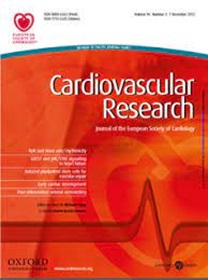Vitamin B6 (pyridoxal 5’ phosphate) antagonizes carotid body P2X3 receptors in hypertension
IF 13.3
1区 医学
Q1 CARDIAC & CARDIOVASCULAR SYSTEMS
引用次数: 0
Abstract
Aims ATP acting on P2X3R within carotid bodies (CBs) underpins chemoreflex-mediated sympathetic overactivity in Spontaneously Hypertensive rats (SHR). Pyridoxal 5’phosphate (PLP), the active form of vitamin B6, is reported as being a non-selective P2X receptor blocker. Hence, we hypothesized that PLP antagonism of P2X3R in the CB would treat hypertension. Methods and Results Herein, we employed a multipronged approach to investigate PLP’s capability to attenuate CB hyperexcitability in hypertension. First, PLP inhibited Ca2+ responses evoked by α, β-methylene ATP in cells lines expressing human (h) P2X3R with IC50 of 8.7µM. Next, in-silico data predicted that PLP binds to the same site of Gefapixant, supporting an allosteric antagonism. Using an isolated perfused carotid artery bifurcation-CB preparation, arterial infusion of PLP (50 µM; 15 min) attenuated CBs sensory firing in SHR (P=0.012). Using the in situ working-heart brainstem preparation, carotid artery injections of PLP (1-5mM) attenuated the chemoreflex-evoked sympathetic (P=0.023) but not phrenic (P=0.62) responses; the CB was stimulated with potassium cyanide (KCN,50 µL; 0.04%). In awake telemetered SHR (n=6), intravenous infusion of PLP (48 mg/Kg/h; 30 min) attenuated KCN-evoked chemoreflex responses and reduced systolic, diastolic, and mean blood pressures (ΔMBP = -15.6 mmHg; P=0.025). Translating our results, we performed a small double-blind randomized clinical trial. In volunteers with hypertension (n=14), oral supplementation with pyridoxine hydrochloride (600 mg) attenuated the hypoxic ventilatory response only in patients with high peripheral chemoreflex sensitivity (P=0.021). Conclusion Our findings suggest that PLP binds to and antagonizes P2X3R and is a viable candidate for larger clinical trials to treat CB dysregulation in cardiovascular diseases.维生素B6(吡哆醛5 '磷酸)拮抗高血压患者颈动脉体P2X3受体
目的ATP作用于颈动脉体(CBs)内P2X3R,是自发性高血压大鼠(SHR)化学反射介导的交感神经过度活动的基础。吡哆醛5 '磷酸(PLP)是维生素B6的活性形式,据报道是一种非选择性P2X受体阻滞剂。因此,我们假设PLP拮抗CB中的P2X3R可以治疗高血压。方法和结果在此,我们采用多管齐下的方法来研究PLP减轻高血压患者CB高兴奋性的能力。首先,PLP抑制α, β-亚甲基ATP在表达人(h) P2X3R的细胞系中引起的Ca2+反应,IC50为8.7µM。接下来,计算机数据预测PLP与Gefapixant的相同位点结合,支持变构拮抗作用。使用离体灌注颈动脉分叉- cb制备,动脉输注PLP(50µM; 15分钟)可减弱SHR的CBs感觉放电(P=0.012)。在原位工作心脏-脑干制备中,颈动脉注射PLP (1-5mM)可减弱化学反射诱发的交感神经反应(P=0.023),但不能减弱膈神经反应(P=0.62);用氰化钾(KCN,50µL; 0.04%)刺激烟叶。在清醒遥测SHR (n=6)中,静脉输注PLP (48 mg/Kg/h; 30分钟)可减弱kcn诱发的化学反射反应,降低收缩压、舒张压和平均血压(ΔMBP = -15.6 mmHg; P=0.025)。翻译我们的结果,我们进行了一项小型双盲随机临床试验。在高血压志愿者(n=14)中,口服盐酸吡哆醇(600 mg)仅在外周化学反射敏感性高的患者中减弱了缺氧通气反应(P=0.021)。结论:我们的研究结果表明,PLP结合并拮抗P2X3R,是治疗心血管疾病中CB失调的更大规模临床试验的可行候选药物。
本文章由计算机程序翻译,如有差异,请以英文原文为准。
求助全文
约1分钟内获得全文
求助全文
来源期刊

Cardiovascular Research
医学-心血管系统
CiteScore
21.50
自引率
3.70%
发文量
547
审稿时长
1 months
期刊介绍:
Cardiovascular Research
Journal Overview:
International journal of the European Society of Cardiology
Focuses on basic and translational research in cardiology and cardiovascular biology
Aims to enhance insight into cardiovascular disease mechanisms and innovation prospects
Submission Criteria:
Welcomes papers covering molecular, sub-cellular, cellular, organ, and organism levels
Accepts clinical proof-of-concept and translational studies
Manuscripts expected to provide significant contribution to cardiovascular biology and diseases
 求助内容:
求助内容: 应助结果提醒方式:
应助结果提醒方式:


